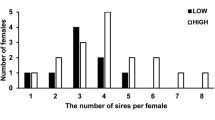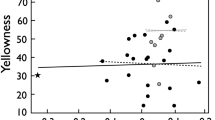Abstract
We investigated the influence of paternal effects on progeny survival of the fugu Takifugu rubripes when multiple families were reared in communal tanks. Four males were crossed with four females in a factorial cross to give 16 families, and the half-siblings sharing the same mother were reared together. Male parentage was determined using microsatellite markers at 35 days. Although the maternal and tank effects were large, it was possible to detect paternal effects in relative survival rate and standard length (standardized in each tank), which were found to be significantly correlated. Paternal effects on growth rate suggest the existence of family-based differences in competition for food. Furthermore, genetic differences affecting larval growth appeared to be partly responsible for the disparity in survival rate observed among families.






Similar content being viewed by others
References
Hosoya S, Kaneko T, Suzuki Y, Hino A (2008) Individual variations in behavior and free cortisol responses to acute stress in tiger pufferfish Takifugu rubripes. Fish Sci 74:755–763
Ogawa K, Inouye K (1997) Parasites of cultured tiger puffer (Takifugu rubripes) and their seasonal occurrences, with descriptions of two new species of Gyrodactylus. Fish Pathol 32:7–14
Nagashima Y, Murata O, Watabe S (2012) Forefront studies on puffer fish and technological development for tiger puffer production. Koseisya Koseikaku, Tokyo (in Japanese)
Shimizu D, Sakiyama K, Sakakura Y, Takatani T, Takahashi Y (2008) Quantitative evaluation of post-release mortality using salt pond mesocosms: case studies of hatchery and wild juvenile tiger puffer. Rev Fish Sci 16:195–203
Gjedrem T, Robinson N, Rye M (2012) The importance of selective breeding in aquaculture to meet future demands for animal protein: a review. Aquaculture 350:117–129
Ayles GB (1974) Relative importance of additive genetic and maternal sources of variation in early survival of young splake hybrid (Salvelinus fontinalis × S. namaycush). J Fish Board Canada 31:1499–1502
Kanis E, Refstie T, Gjedrem T (1976) A genetic analysis of egg, alevin and fry mortality in Salmon (Salmo saler) and Rainbow Trout (Salmo gairdneri). Aquaculture 8:259–268
Rye M, Lillevik KM, Gjerde B (1990) Survival in early life of Atlantic salmon and rainbow trout: estimates of heritabilities and genetic correlations. Aquaculture 89:209–216
Herbinger CM, O’Reilly PT, Doyle RW, Wright JM, O’Flynn F (1999) Early growth performance of Atlantic salmon full-sib families reared in single family tanks versus in mixed family tanks. Aquaculture 173:105–116
Gjerde B, Terjesen BF, Barr Y, Lein I, Thorland I (2004) Genetic variation for juvenile growth and survival in Atlantic cod (Gadus morhua). Aquaculture 236:167–177
Ruttanapornvareesakul Y, Sakakura Y, Hagiwara A (2007) Effect of tank proportions on survival of seven-band grouper Epinephelus septemfasciatus (Thunberg) and devil stinger Inimicus japonicus (Cuvier) larvae. Aquac Res 38:193–200
Oshima M, Kato Y, Masuda R, Kimura S, Yamashita Y (2009) Effect of turbulence on feeding intensity and survival of Japanese flounder Paralichthys olivaceus pelagic larvae. J Fish Biol 75:1639–1647
Thodesen J, Rye M, Wang YX, Li SJ, Bentsen HB, Gjedrem T (2013) Genetic improvement of tilapias in China: genetic parameters and selection responses in growth, pond survival and cold-water tolerance of blue tilapia (Oreochromis aureus) after four generations of multi-trait selection. Aquaculture 416–417:354–366
Hara M, Sekino M (2006) Genetic differences between hatchery stocks and natural populations in Pacific Abalone (Haliotis discus) estimated using microsatellite DNA markers. Mar Biotechnol 9:74–81
McLean JE, Seamons TR, Dauer MB, Bentzen P, Quinn TP (2008) Variation in reproductive success and effective number of breeders in a hatchery population of steelhead trout (Oncorhynchus mykiss): examination by microsatellite-based parentage analysis. Conserv Genet 9:295–304
Wang HP, Li L, Wallat G, Brown B, Yao H, Gao Z, Tiu L, O’Bryant P, Rapp D, MacDonald R (2009) Evaluation of relative growth performance and genotype by environment effects for cross-bred yellow perch families reared in communal ponds using DNA parentage analyses. Aquac Res 40:1363–1373
Nagler JJ, Parsons JE, Cloud JG (2000) Single pair mating indicates maternal effects on embryo survival in rainbow trout, Oncorhynchus mykiss. Aquaculture 184:177–183
Berg OK, Hendry AP, Svendsen B, Bech C, Arnekleiv JV, Ohrmann AL (2001) Maternal provisioning of offspring and the use of those resources during ontogeny: variation within and between Atlantic salmon families. Funct Ecol 15:13–23
Vandeputte M, Quillet E, Chevassus B (2002) Early development and survival in brown trout (Salmo trutta fario L.): indirect effects of selection for growth rate and estimation of genetic parameters. Aquaculture 204:435–445
Smoker WW, Wang IA, Gharrett AJ, Hard JJ (2004) Embryo survival and smolt to adult survival in second-generation outbred coho salmon. J Fish Biol 65(s1):254–262
Patton SJ, Kane SL, Wheeler PA, Thorgaard GH (2007) Maternal and paternal influence on early embryonic survival of androgenetic rainbow trout (Oncorhynchus mykiss): implications for measuring egg quality. Aquaculture 263:26–34
Hamoutene D, Lush L, Drover D, Walsh A (2009) Investigation of the temporal effects of spawning season and maternal and paternal differences on egg quality in Atlantic cod Gadus morhua L. broodstock. Aquac Res 40:1668–1679
Wedekind C, Muller R, Spicher H (2001) Potential genetic benefits of mate selection in whitefish. J Evol Biol 14:980–986
Wedekind C, Jacob A, Evanno G, Nussle S, Muller R (2008) Viability of brown trout embryos positively linked to melanin-based but negatively to carotenoid-based colours of their fathers. Proc R Soc B 275:1737–1744
McCormick M (1998) Behaviorally induced maternal stress in a fish influences progeny quality by a hormonal mechanism. Ecology 79:1873–1883
Schreck CB, Contreras-Sanchez W, Fitzpatrick MS (2001) Effects of stress on fish reproduction, gamete quality, and progeny. Aquaculture 197:3–24
Giesing ER, Suski CD, Warner RE, Bell AM (2011) Female sticklebacks transfer information via eggs: effects of maternal experience with predators on offspring. Proc R Soc B 278:1753–1759
Brown CL, Doroshov SI, Nunez JM, Hadley C, Vaneennaam J, Nishioka RS, Bern HA (1988) Maternal triiodothyronine injection cause increases in swimbladder inflation and survival rates in larval striped bass Morone saxatilis. J Exp Zool 248:168–176
Maruyama A, Rusuwa B, Yuma M (2003) Interpopulational egg-size variation of landlocked Rhinogobius goby related to the risk of larval starvation. Env Biol Fish 67:223–230
Paez DJ, Morrissey M, Bernatchez L, Dodson JJ (2010) The genetic basis of early-life morphological traits and their relation to alternative male reproductive tactics in Atlantic salmon. J Evol Biol 23:757–768
Takeuchi T, Watanabe T, Ogino C, Saito M, Nishimura K, Nose T (1981) Effects of low protein-high calory diets and deletion of trace elements from a fish meal diet on reproduction of rainbow trout (in Japanese with English abstract). Bull Japan Soc Sci Fish 47:645–654 (in Japanese with English abstract)
Tamada K, Iwata K (2005) Intra-specific variations of egg size, clutch size and larval survival related to maternal size in amphidromous Rhinogobius goby. Env Biol Fish 73:379–389
Watanabe K, Arakawa T, Kitajima C, Fujita S (1984) Effect of nutritional quality of broodstock diets on reproduction of red sea bream. Nippon Suisan Gakk 50:495–501 (in Japanese with English abstract)
Kennedy J, Geffen AJ, Nash RDM (2007) Maternal influences on egg and larval characteristics of plaice (Pleuronectes platessa L.). J Sea Res 58:65–77
Chuda H, Matsuyama M, Hara H, Yada T, Matsuura S (1998) Relationship between post-ovulation time and fertilization rate of eggs in artificial insemination of tiger puffer, Takifugu rubripes. Nippon Suisan Gakk 64:993–998 (in Japanese with English abstract)
Kuroyanagi M, Katayama T, Imai T, Yamamoto Y, Chisada S, Yoshiura Y, Ushijima T, Matsushita T, Fujita M, Nozawa A, Suzuki Y, Kikuchi K, Okamoto H (2013) New approach for fish breeding by chemical mutagenesis: establishment of TILLING method in fugu (Takifugu rubripes) with ENU mutagenesis. BMC Genom 14:786
Kai W, Kikuchi K, Fujita M, Suetake H, Yoshiura Y, Ototake M, Fujiwara A, Venkatesh B, Miyaki K, Suzuki Y (2005) A genetic linkage map for the tiger pufferfish, Takifugu rubipes. Genetics 171:227–238
Kai W, Kikuchi K, Tohari S, Chew AK, Tay A, Fujiwara A, Hosoya S, Suetake H, Naruse K, Brenner S, Suzuki Y, Venkatesh B (2011) Integration of the genetic map and genome assembly of fugu facilitates insights into distinct features of genome evolution in teleosts and mammals. Genome Biol Evol 3:424–442
Benjamini Y, Hochberg Y (1995) Controlling the false discovery rate: a practical and powerful approach to multiple testing. J Royal Stat Soc Ser B 57:289–300
Benjamini Y, Yekutieli D (2001) The control of the false discovery rate in multiple testing under dependency. Annals Stat 29:1165–1188
R Core Team (2013) R: A language and environment for statistical computing. R Foundation for Statistical Computing, Vienna, Austria (http://www.R-project.org/)
Anderson JT (1988) A review of size dependent survival during pre-recruit stages of fishes in relation to recruitment. J Northwest Atl Fish Soc 8:55–66
Fukuhara O (1988) Morphological and functional development of larval and juvenile Limanda yokohamae (Pisces: pleuronectidae) reared in the laboratory. Mar Biol 99:271–281
Hare JA, Cowen RK (1997) Size, growth, development, and survival of the planktonic larvae of Pomatomus saltatrix (Pisces: pomatomidae). Ecology 78:2415–2431
Miller TJ, Crowder LB, Rice JA, Marschall EA (1988) Larval size and recruitment mechanisms in fishes: toward a conceptual framework. Can J Fish Aquat Sci 45:1657–1670
Morote E, Olivar MP, Pankhurst PM, Villate F, Uriarte I (2008) Trophic ecology of bullet tuna Auxis rochei larvae and ontogeny of feeding-related organs. Mar Ecol Prog Ser 353:243–254
Shirota A (1970) Studies on the mouth size of fish larvae. Bull Japan Soc Sci Fish 36:353–368 (in Japanese with English abstract)
Hosoya S, Kido S, Hirabayashi Y, Kai W, Kinami R, Yoshinaga T, Ogawa K, Suetake H, Kikuchi K, Suzuki Y (2013) Genomic regions of pufferfishes responsible for host specificity of a monogenean parasite, Heterobothrium okamotoi. Int J Parasitol 43:909–915
Fuji K, Hasegawa O, Honda K, Kumasaka K, Sakamoto T, Okamoto N (2007) Marker-assisted breeding of a lymphocystis disease-resistant Japanese flounder (Paralichthys olivaceus). Aquaculture 272:291–295
Meuwissen THE, Hayes BJ, Goddard ME (2001) Prediction of total genetic value using genome-wide dense marker maps. Genetics 157:1819–1829
Acknowledgments
The authors acknowledge the help of Yuka Jo and Masashi Fujita in running the experiment. This work was supported by a Grant-in-Aid for Young Scientists (B) from the Japan Society for the Promotion of Science (JSPS) (no. 25850134).
Author information
Authors and Affiliations
Corresponding author
Electronic supplementary material
Below is the link to the electronic supplementary material.
Rights and permissions
About this article
Cite this article
Hosoya, S., Mizuno, N., Kikuchi, K. et al. Rearing Takifugu rubripes larvae in communal tanks: paternal genetic contribution to survivability. Fish Sci 80, 1037–1043 (2014). https://doi.org/10.1007/s12562-014-0795-x
Received:
Accepted:
Published:
Issue Date:
DOI: https://doi.org/10.1007/s12562-014-0795-x




